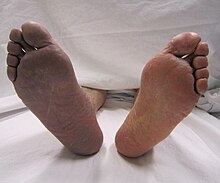User:Mr. Ibrahem/Acute limb ischaemia
| Acute limb ischaemia | |
|---|---|
| Other names | Acute limb ischemia, acute arterial occlusion |
 | |
| Acute embolism to the right femoral artery resulting in ischemia | |
| Specialty | Vascular surgery |
| Symptoms | Pale, painful, numb, immobile, pulseless, cool limb[1] |
| Complications | Compartment syndrome[1] |
| Usual onset | Hours to days[2] |
| Types | Stage I, IIa, IIb, III[3] |
| Causes | Thrombosis, embolism, dissection, trauma[2] |
| Risk factors | Smoking, diabetes, obesity, sedentary lifestyle, family history, high cholesterol, high blood pressure, atrial fibrillation[1][2] |
| Diagnostic method | Based on symptoms, confirmed by CT angiogram[1] |
| Differential diagnosis | Chronic limb ischemia[2] |
| Treatment | Surgery, thrombolysis[1] |
| Medication | Unfractionated heparin, pain management[1] |
| Frequency | 15 to 22 per 100,000 per year[1][3] |
Acute limb ischaemia (ALI) occurs when there is a sudden decrease in blood flow to a limb.[3] Symptoms classically include a pale, painful, numb, immobile, pulseless, and cool limb.[1] While any limb may be involves, the legs are most commonly affected.[1] Complications may include compartment syndrome.[1]
The most common cause is a thrombosis, often in the setting of peripheral artery disease (PAD).[1] Other causes may include embolism, dissection, or trauma.[2] Risk factors include smoking, diabetes, obesity, sedentary lifestyle, family history, high cholesterol, and high blood pressure.[1] Diagnosis may be suspected based on symptoms and confirmed by CT angiogram.[1] In contrast, chronic limb threatening ischemia develops more gradually, and while there may be no pulse, symptoms are present for more than 2 weeks.[4]
Treatment is generally by prompt surgery; which may include surgical bypass, endarterectomy, or embolectomy.[1] Catheter-directed thrombolysis may be another option.[1] While awaiting surgery unfractionated heparin and pain management is frequently provided.[1] If treatment is delayed amputation may be required.[1] About 15% of people die within a year, often due to associated health problems.[2]
ALI occur in about 15 to 22 per 100,000 people per year.[1][3] Males and females are affected equally frequently.[1] The typical age of onset is 75.[1] Successful surgery to manage acute limb ischemia was first performed in 1911.[5] The word ischemia is from the Greek ischein meaning "to hold" and haima meaning "blood".[6]
References[edit]
- ^ a b c d e f g h i j k l m n o p q r s t Smith, DA; Lilie, CJ (January 2021). "Acute Arterial Occlusion". PMID 28722881.
{{cite journal}}: Cite journal requires|journal=(help) - ^ a b c d e f Creager, Mark A.; Kaufman, John A.; Conte, Michael S. (2012). "Acute Limb Ischemia". New England Journal of Medicine. 366 (23): 2198–2206. doi:10.1056/NEJMcp1006054. PMID 22670905.
- ^ a b c d Santistevan, JR (November 2017). "Acute Limb Ischemia: An Emergency Medicine Approach". Emergency medicine clinics of North America. 35 (4): 889–909. doi:10.1016/j.emc.2017.07.006. PMID 28987435.
- ^ Farber, A (12 July 2018). "Chronic Limb-Threatening Ischemia". The New England Journal of Medicine. 379 (2): 171–180. doi:10.1056/NEJMcp1709326. PMID 29996085.
- ^ Lanzer, Peter; Topol, Eric J. (2002). Pan Vascular Medicine: Integrated Clinical Management. Springer Science & Business Media. p. 1353. ISBN 978-3-540-41484-1. Archived from the original on 2021-08-27. Retrieved 2021-03-04.
- ^ "Definition of ISCHEMIA". www.merriam-webster.com. Archived from the original on 23 September 2020. Retrieved 4 March 2021.
